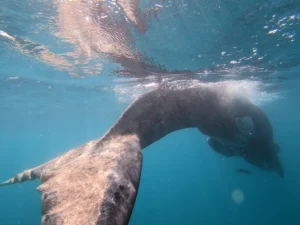Salps are fascinating gelatinous zooplankton that play a significant role in ocean ecosystems. These tunicates belong to the phylum Chordata and are known for their unique life cycle, filter feeding behaviour, and ecological importance as carbon sequestrators. Despite their similar gelatinous appearance, salps are in fact not related to jellyfish, having diverged 800 million years ago. They are found in polar to tropical waters in oceans worldwide, with abundance varying widely – depending on factors such as water temperature, nutrient availability, and the presence of predators.
These transparent tubular animals move by contracting and relaxing their bodies, expelling water and propelling themselves forward. This jet propulsion is extremely effective, placing salps among the most efficient species making use of this method of locomotion. Their gelatinous bodies consist of a complex structure called a “tunic,” composed mainly of cellulose. This tunic provides buoyancy and protection, and its transparency makes salps nearly invisible in the water, allowing them to avoid predators.
Salps primarily feed on phytoplankton, microscopic plant-like organisms that float in the water column. By consuming phytoplankton, salps play a vital role in regulating the ocean’s primary production and carbon cycling. They aid in the transfer of energy and nutrients from lower trophic levels to higher levels, in turn providing food for over 200 marine animals, including small fish, crustaceans, and even some whales. Furthermore, the process of filter feeding by salps results in the production of faecal pellets, which are rich in nutrients and carbon. These pellets sink to the ocean’s depths, contributing to the vertical transport of carbon and nutrients. This has implications for the ocean’s biological pump, a process that transports carbon dioxide from the atmosphere to the deep ocean, potentially influencing global climate patterns.

Salps are however thought to be impacted by climate change and ocean acidification. Some studies suggest that increasing ocean temperatures could lead to changes in the abundance and distribution of salps, with potential consequences for marine food webs. Additionally, the acidification of oceans due to increased carbon dioxide levels can affect the salps’ ability to form their protective tunics, potentially impacting their survival and ecology. We tend to encounter salps at our snorkeling and freediving sites after a period of heavy wind or swell and are often accompanied by jellyfish.
Salps are ecologically important marine organisms with a fascinating life cycle and filter-feeding behaviour. Their importance as a fundamental food source for many marine organisms along with their role in carbon sequestration make them significant players in ocean ecosystems. Understanding the ecology of salps is not only essential for comprehending marine food webs and nutrient cycling but also for predicting how these organisms might respond to ongoing environmental changes.



